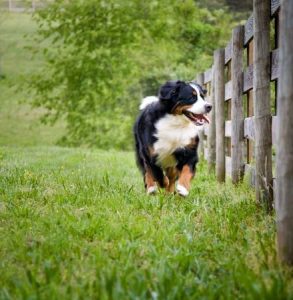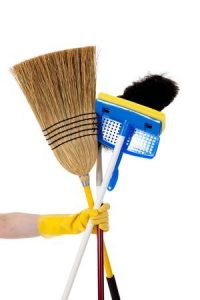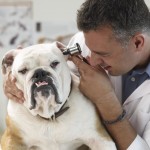Now that spring is here, you can finally get started on all of those projects you’ve been waiting for! You’re probably going to start the traditional spring cleaning of your home, you might begin planting your outdoor garden and you definitely will want to spend more time outdoors with your dog. Spring is the perfect time for you and your four-legged friend to play outside and enjoy the fine weather, and as pet parents, we need to be aware of certain hazards that come along with the warmer spring days. So here are some spring pet care tips that can help you and your dog enjoy the much welcome springtime weather.
Allergies
Along with warmer weather and longer days, springtime can also bring dust and pollen which can trigger springtime allergies in your dog. While there are many different types of allergies that can affect your dog including contact allergies (caused by something your dog comes in direct contact with), allergies from flea bites or even food allergies, environmental allergies are most commonly seen during the spring season. Environmental allergens can include pollen from trees, grasses, weeds and flowers, mold spores or house dust mites. Common signs that your dog is experiencing environmental allergies include runny eyes, sneezing, increased itching and scratching, itchy ears and ear infections, itchy skin or hot spots, constant licking, rubbing of the face and chewing at the feet. Also, dogs that suffer from environmental allergies may also develop secondary skin infections which can cause hair loss or scabbing. Any breed of dog can develop allergies at any time during their life, but allergies seem to be more common in Terriers, Retrievers and flat face breeds such as Bulldogs or Pugs. So one important spring pet care tip is to keep an eye on your dog and visit your veterinarian if you suspect that your dog has springtime allergies. Your vet will examine your dog and take down a complete history of his symptoms; he will probably also recommend skin or blood tests and try to find out what’s causing the allergic reaction. In some cases your vet may also prescribe a bathing schedule to help heal your dog’s irritated skin or he may also prescribe medications to help alleviate the itchiness. Additionally, your dog may also benefit from a supplement with Omega 3 fatty acids such as MaxiDerm to help with dry, itchy skin.
There are a few things you can do at home that may help your dog if he has springtime allergies – you can try using home air purifiers, clean inside your home using a damp cloth to pick up extra residual dust, and keep your dog indoors in the early morning and late evening when the pollen counts are typically the highest.
Spring Cleaning
This is also the time of year that we start the traditional spring cleaning in our homes, so this is the perfect time to look around your house and remove or safely put away anything that could possibly be hazardous to your dog.
Medications – Over the counter human medications can be toxic to dogs, so be sure to put all medications in a safe place where your dog cannot reach them. Even if the medicine bottle has a childproof cap on it, your dog can still chew through the container and consume the contents. Also, if you’re dispensing medication for yourself and you accidentally drop a pill on the floor, make sure to pick it up quickly before your curious dog finds it and swallows it. You’ll also want to keep creams or ointments safely stored in a place where your dog can’t reach – even if the containers are sealed, your dog could still chew through the outer packaging. Veterinary drugs that have been prescribed for your pets should also be safely stored away from your dog’s reach; many dog medications are specifically flavored to make them tasty, so your dog could easily be tempted to ingest the entire contents of the bottle.
Rodenticides and insecticides – Mouse and rat poisons (rodenticides) and insect control products (insecticides) are often made with attractants that your dog may also find interesting, and both contain a number of toxins that can be extremely dangerous to your dog. Rodenticides are typically made with anticoagulants, cholecalciferol, bromethalin, and phosphide, which can have devastating effects on your dog if eaten. If your dog accidentally consumes mouse or rat poison or is exposed to insecticides, call your veterinarian immediately for life-saving treatment recommendations.
Household cleaning products (such as bleach, drain cleaners, ammonia and toilet bowl cleaners) can also be extremely dangerous to dogs, so if you use any of these cleaning products, make sure to read the warning labels and store them safely out of your dog’s reach. Whenever possible, try using pet-friendly non-toxic cleaning products when you’re cleaning around your house.
Other household items that could potentially cause problems for your dog include poisonous indoor house plants; strings, rubber bands or yarn which your dog could accidentally swallow and cause intestinal blockage; and children’s toys with small removable parts or small rubber balls that your dog could swallow and choke on. There are also common human foods that can be dangerous to dogs, such as chocolate, grapes and raisins, and should always be kept out of your dog’s reach. You can read more about foods that are bad for dogs here.
If you think that your dog has been exposed to any toxic or poisonous substance, call your veterinarian immediately. Two other great resources to keep on hand are the ASPCA Animal Poison Control Center (APCC) (888-426-4435) and the Pet Poison Helpline (855-213-6680).
Outdoor Gardening
Another important spring pet care tip is to make sure that your outdoor garden is pet friendly, especially since this is the time of year that we enjoy planting our new spring flowers and vegetables. Many popular flowers, plants and vegetables can be hazardous to your pet if consumed, so you will need to do some research and select only plants that are safe for dogs. Most garden nurseries post signs about which plants are safe for dogs and you can find a complete list of toxic and non-toxic plants for your home and garden here. Also, keep in mind that many dogs enjoy digging in the yard, so you’ll also want to select bulbs that are not toxic to dogs. If you use fertilizers, herbicides or mulch to keep your plants and grass green and healthy, the ingredients in these products can be dangerous if ingested by your dog. It’s better to avoid using pesticides altogether, but if you must use them to control weeds or insects, make sure you follow the directions carefully and store the products in a location that your dog cannot reach.
Pesky Pests
Along with the warmer weather, springtime also means that fleas, ticks and mosquitoes are going to return. Here are some spring pet care tips to help you manage a few of these pesky pests.
Fleas – While it may be impossible to avoid fleas completely during the spring and summer season, you can still manage fleas (and allergies caused by fleas) by starting a flea control program for your dog and your other pets. Fleas, which can be found all across the country, tend to like warmer, more humid locations. According to AAHA (American Animal Hospital Association), one flea can multiply into 1,000 fleas in just 21 days. Typically, your dog will pick up fleas by being outdoors or by spending time with other animals. Once inside your home, fleas can quickly multiply and infest carpets, furniture and human and dog bedding. Fleas will host on your dog’s blood and when they bite, it can be very irritating and lead to itching, scratching and possible hair loss or scabbing. Adult fleas can also cause anemia, dermatitis or tapeworms (by ingesting an infected flea that is carrying tapeworm larvae). One of the easiest ways to check for fleas is to use a flea comb, checking your dog thoroughly before he comes back inside the house. Also, there are numerous flea treatment solutions available including flea shampoos, collars, powders and spot treatments. For the best flea control products and solutions for your dog, you’ll want to speak with your veterinarian for advice and recommendations.
Ticks – Whether you are hiking on woodsy trails or playing in a grassy park, your dog can easily pick up ticks when he’s spending time outdoors. Ticks are very small and can be hard to detect, but if you’ve been outside with your dog you should check him for ticks so that if he does have one, it can be removed before it causes damage. Ticks are usually found around your dog’s head, ears, neck, chest and front legs, though they can be end up anywhere on your dog. Ticks can cause a variety of health risks, including blood loss, anemia and skin irritation or infection. Ticks can also transmit diseases such as Rocky Mountain spotted fever, Lyme disease, ehrlichiosis, anaplasmosis or “tick paralysis“. You can speak to your veterinarian about tick medications, collars and check ups. Also, you can help prevent ticks from establishing themselves in your backyard by keeping the grass cut low especially around trees, shrubs and fence lines. If you have wood piles or debris in your yard, have it removed since ticks could possibly be hiding in these areas, too.
Mosquitoes – Depending on where you live, mosquitoes typically become active in the springtime and as the weather gets warmer, mosquitoes will become more prevalent especially in areas where there is standing water. The mosquito larvae typically hatch within a few days and a full adult mosquito will develop within 10 to 14 days. Mosquitoes not only cause itchy bumps, but they can also carry serious diseases such as West Nile Virus (WNV), roundworms and heartworms. You can help prevent (or at least reduce) mosquito breeding sites by eliminating areas where there is standing water. Outdoor water dishes or bird baths should be regularly cleaned and replaced with fresh water, and check around your flower pots or empty buckets where water can collect. You’ll want to keep screens on your windows and doors so that mosquitoes cannot come inside the house, and you can also minimize outside activity between dawn and dusk when mosquitoes tend to be more active.
Spring is a great time to make an appointment with your veterinarian for a wellness checkup for your dog, and this is a good time to discuss with your vet different options to make sure your pet is protected against fleas, ticks and heartworm.
Stinging Insects – Dogs tend to be curious by nature, and sometimes that means they get too close to bees, hornets, wasps or ant hills. Depending on the type of insect and your dog’s allergic reaction, your dog may only experience mild discomfort, but sometimes the reactions can be more serious and could require medical attention. If your dog gets stung, it’s best to call your veterinarian and describe your dog’s symptoms so you can decide what the course of action should be.
Proper ID and Microchipping
Now that the weather is warm, this means that you’re going to be outside a lot more with your dog. From hiking trips, going to the beach, or playing in the park, you’re going to want to make sure that your dog has a collar with an identification tag that is up to date with your current home address and phone numbers. Additionally, it’s a good idea to have your dog microchipped as an extra level of protection in case your dog somehow loses his collar and ID tags. Microchips, which are about the same size as a grain of rice, are implanted just under the skin usually between the dog’s shoulder blades. The microchip contains the registration number and phone number of the registry for that specific brand of chip. If your dog gets lost or separated from you, a handheld scanner (most veterinarian offices or animal shelters have one) can read the radio frequency of the chip which will display the information. Most veterinarian offices can easily implant the microchip in your dog during a routine visit, as no surgery or anesthesia is required. Once the microchip has been implanted, you’ll also need to register your dog with the microchip company so they have all of your contact information.
So now that spring is here, go out and enjoy the beautiful weather with your four legged best friend. And by following some of these spring pet care tips, you can safely enjoy the spring season. Do you have any springtime tips to share?










Leave a Reply